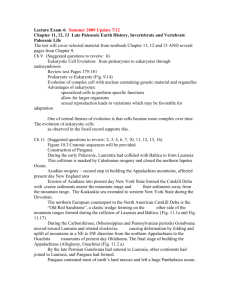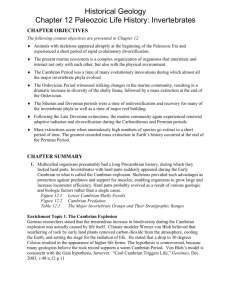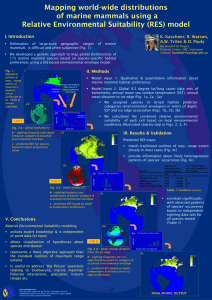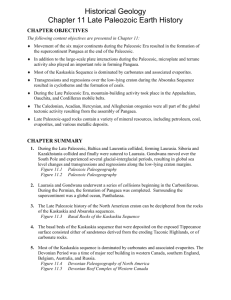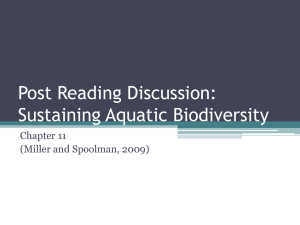chapter12 Paleozoic
advertisement
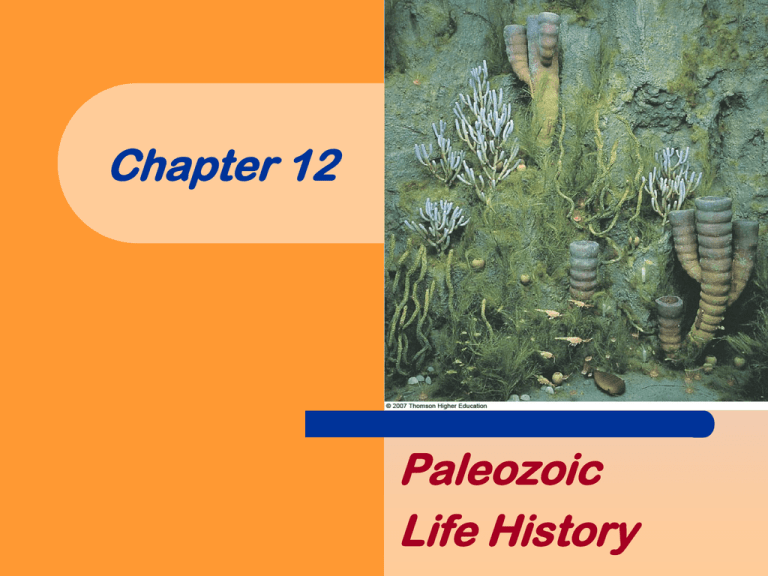
Chapter 12 Paleozoic Life History Introduction Animals with skeletons appeared abruptly at the beginning of the Paleozoic Era and experienced a short period of rapid evolutionary diversification. Geo-inSight 1., p. 572 Introduction During the Paleozoic Era, the invertebrates experienced several times of diversification. These were followed by extinction, culminating in the greatest recorded mass extinction in Earth’s history at the end of the Permian Period. p. 561 What Was The Cambrian Explosion? Multicelled organisms presumably had a long Precambrian history, but they lacked hard parts. Multicelled Organisms evolved to invertebrates with hard parts during the Early Cambrian in what is called the “Cambrian explosion”. Fig. 21.1a, p. 563 The Emergence of A Shelly Fauna Hard parts probably evolved as a result of various geologic and biologic factors rather than from a single cause. Sea creatures began to grow shells or exoskeletons provided such advantages as: Protection from the sun Why ? Moisture Retention Why? Muscular Support for muscles, enabling organisms to grow large and Protection from Predators Fig. 21.1b, p. 563 Paleozoic Invertebrate Marine Life The Present Marine Ecosystem Marine organisms are classified as Plankton – the floaters Nekton – the swimmers Benthos - if they live on or in the seafloor. Fig. 21.2, p. 565 Paleozoic Invertebrate Marine Life The Present Marine Ecosystem Marine organisms are divided into four basic feeding groups: Suspension feeders - consume microscopic plants and animals as well as dissolved nutrients from water Herbivores - the plant eaters Carnivores – the scavengers, which are meat eaters Sediment-deposit feeders - ingest sediment and extract nutrients from it. Fig. 21.2, p. 565 Paleozoic Invertebrate Marine Life Cambrian Marine Community The Cambrian invertebrate community was dominated by three major groups: Trilobites, Brachiopods, and Archaeocyathids. Little specialization existed among the invertebrates, and most phyla were represented by only a few species. Fig. 21.4, p. 566 Invertebrates and Guide Fossils or Index Fossils Paleozoic Invertebrate Marine Life The Burgess Shale Biota The Middle Cambrian Burgess Shale contains one of the finest examples of a well-preserved soft-bodied biota in the world. Fig. 21.6b-d, p. 567 Paleozoic Invertebrate Marine Life Ordovician Marine Community The Ordovician marine invertebrate community marked the beginning of the dominance by the shelly fauna and the start of large-scale reef building. The end of the Ordovician Period was a time of major extinctions of many invertebrate phyla. Fig. 21.7, p. 568 Paleozoic Invertebrate Marine Life Silurian and Devonian Marine Communities The Silurian and Devonian Periods were times of diverse faunas dominated by reef-building animals. Fig. 21.8, p. 569 Fig. 21.9, p. 569 Paleozoic Invertebrate Marine Life Carboniferous and Permian Marine Communities The Carboniferous and Permian Periods saw a great decline in invertebrate diversity. Fig. 21.12, p. 571 Paleozoic Invertebrate Marine Life The Permian Marine Invertebrate Mass Extinction A major extinction occurred at the end of the Paleozoic Era, affecting the invertebrates as well as the vertebrates. Its cause is still being debated. Fig. 21.13, p. 571 Vertebrate Evolution Chordates are characterized by a notochord, dorsal hollow nerve cord, and gill slits. The earliest chordates were soft-bodied organisms that were rarely fossilized. Vertebrates are a subphylum of the chordates. They had spinal cords but no Jaws “Ostracoderms” Fish Fish are the earliest known vertebrates, with their first fossil occurrence in Upper Cambrian rocks. They diversified rapidly during the Paleozoic Era. Cenozoic Mesozoic Neogene Paleogene Cretaceous Jurassic Triassic Paleozoic Permian Carboniferous Ostracoderms Devonian Silurian Ordovician Cambrian Cartilaginous fish Placoderms Lobe-finned fish Acanthodians Ray-finned fish Fish They have had a long and varied history, including jawless and jawed armored forms (ostracoderms and placoderms), cartilaginous forms, and bony forms. Fig. 21.18, p. 576 Fish Crossopterygians, a group of lobefinned fish, gave rise to the amphibians. The link between crossopterygians and the earliest amphibians is convincing and includes a close similarity of bone and tooth structures. The transition from fish to amphibians occurred during the Devonian. Fig. 21.23, p. 579 Amphibian Vertebrates Invade The Land Amphibians first appear in the fossil record during the Devonian, having made the transition from water to land. They became extremely abundant during the Pennsylvanian Period when coal forming swamps were widespread. During the Carboniferous, the labyrinthodont amphibians were the dominant terrestrial vertebrate animals. Fig. 21.22, p. 578 Evolution of The Reptiles The Land Is Conquered The evolution of the amniote egg allowed reptiles to colonize all parts of the land beginning in the Late Mississippian. The earliest fossil record of reptiles is from the Late Mississippian. Fig. 21.27, p. 582 Evolution of The Reptile The Land Is Conquered Pelycosaurs or sail-back reptiles were the dominant reptile group during the Early Permian. The therapsids or mammal-like reptiles dominated the landscape for the rest of the Permian Period. Fig. 21.29, p. 583 Fig. 21.30, p. 583 Plant Evolution In making the transition from water to land, plants had to overcome the same basic problems as animals -namely, desiccation, reproduction, and gravity. Table 21.3, p. 584 Plant Evolution The earliest fossil record of land plants is from Middle to Upper Ordovician rocks. These plants were probably small and bryophyte-like in their overall organization. The evidence comes from spores released by plants, not actual plant fossils. Plant Evolution The oldest known vascular land plants first appear in the Middle Silurian. The evolution of vascular tissue was an important event in plant evolution. It allowed food and water to be transported throughout the plant and provided the plant with additional support. Fig. 21.35, p. 589 Plant Evolution The ancestor of terrestrial vascular plants was probably some type of green algae This is based on such similarities as: Pigmentation Metabolic enzymes Reproductive cycles Plant Evolution Silurian and Devonian Floras The earliest seedless vascular plants were small, leafless stalks with spore-producing structures on their tips. From this simple beginning, plants evolved many of the major structural features characteristic of today’s plants. Fig. 21.31, p. 585 Plant Evolution Silurian and Devonian Floras By the end of the Devonian Period, forests with tree-sized plants up to 10 m tall had evolved. The Late Devonian also witnessed the evolution of flowerless seed plants (gymnosperms) whose reproductive style freed them from having to stay near water. Fig. 21.32, p. 585 Plant Evolution Late Carboniferous and Permian Floras The Carboniferous Period was a time of vast coal swamps, conditions ideal for the seedless vascular plants. Seedless vascular plants, such as ferns, were very abundant during the Pennsylvanian Period. Fig. 21.34, p. 588 Plant Evolution Late Carboniferous and Permian Floras With the onset of more arid conditions during the Permian, the gymnosperms became the dominant element of the world’s forest. End of Chapter 12
